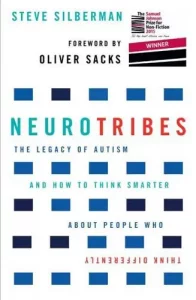 Neurotribes is a journey through the history of autism, and I’m sorry to say that some of that history is almost incomprehensibly cruel. Like the Nazi policy turning long-care institutions for the care of disabled children into death factories – actually run by the doctors and nurses. And the psychoanalytic theory that blamed ‘refrigerator’ mothers for their child’s condition. And the use of electric shocks to ‘train’ autistic children into neurotypical behaviour…
Neurotribes is a journey through the history of autism, and I’m sorry to say that some of that history is almost incomprehensibly cruel. Like the Nazi policy turning long-care institutions for the care of disabled children into death factories – actually run by the doctors and nurses. And the psychoanalytic theory that blamed ‘refrigerator’ mothers for their child’s condition. And the use of electric shocks to ‘train’ autistic children into neurotypical behaviour…
Asperger’s. Aspies. Hans Asperger was not the only scientist to study of autism, but it was his decade of hands-on research at the Children’s Clinic at the University of Vienna in the 1920s that led to the his name being attached to the syndrome. Asperger realised that the condition was more like a continuum, and he recognised the special talents and abilities that it conferred on some of his patients; he called them his ‘little professors’. Then came the rise of Hitler, and the wholesale euthanasia – dubbed ‘negative population policies’ – of disabled children. (Killing was called ‘final medical assistance’!) Asperger’s role seems murky, though he did try to advocate for his ‘little professors’ by stressing the possible uses of their unusual intelligence. After the end of WWII, Asperger’s original concept of autism as ‘a broad and inclusive spectrum…that was “not at all rare” was buried with the ashes of his clinic and the unspeakable memories of that dark time, along with his case records. Much of his writing was never translated from the German, and it was left to another European medico, Baltimore child psychiatrist Leo Kanner, to become the world’s foremost expert. By now, we are so used to thinking of autism as a spectrum that it comes as a bit of a surprise to find out that in the United States the concept was largely lost for decades.
After detailing this early history, Silberman hits his stride with a savage critique of the American medical and psychiatric establishment in the ’50’s and’60’s. Apart from the outright cruelty meted out to autistic children and adults, it’s the sheer wrong-headedness of the ‘experts’ that is so confronting. Kanner’s conception of autism ruled, and it was narrower than Asperger’s. In his opinion, it was was condition of childhood only (thus ignoring autistic teenagers and adults completely) and extremely rare. It became widely accepted that autistic children were not educable and should be institutionalised.
Desperate parents tried medication, behavioural modification, ECT, dietary interventions, psychotherapy and all sorts of expensive quackery. The search for a cause and a cure led to all sorts of theories, from genetic abnormality to toxic chemicals from industry to poor parenting. Imagine routinely telling mothers their child’s autism is their fault for being cold, unresponsive ‘refrigerator mothers’. No wonder autism was a devastating diagnosis.
But there are positive and hopeful stories in here too. One of the real heroes of the book is Dr Lorna Wing, the British psychiatrist who coined the phrase ‘autism spectrum’, and whose mission was to discover what kinds of treatment, assistance and services autistic people and their families needed. Did it help that she was a woman, and that she herself had an autistic child? All sorts of neurodiverse lives are better because of her compassionate, practical approach.
I could go on and on…but it’s a long book! I thoroughly recommend Neurotribes if you are interested in neurodivergence; Silberman has written a deeply human history and made sense of a complex, troubling and epic topic. It made me think about my time working in a ‘sheltered workshop’ with intellectually handicapped adults in the late 1970s.
If they’d been born in Germany in the 1920s and ’30’s, they could have been killed as babies or toddlers. I started to remember their unique personalities; I can still hear Joey imitating car engines, bird calls, radio hosts, pop songs and more with spooky accuracy, and the way Ellen would ‘twinkle’ her fingers when she was thinking (which is a little habit I caught and still, even now, revert to at times). There were dramas, problems and meltdowns, but also laughter and much affection.
After reading Neurotribes I wonder how many of our clients were autistic. With the right kind of targeted education and therapy, would they have had more fulfilling lives?
